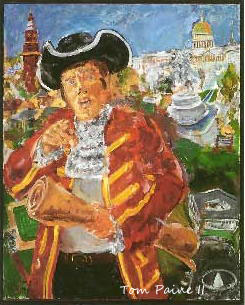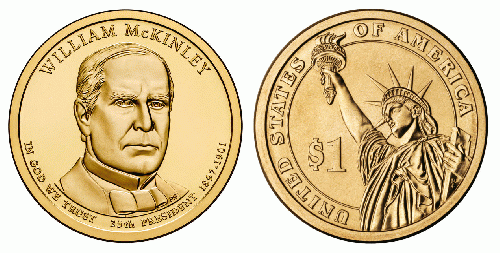1. The United States Doesn't Even Know What Its $1 Coin Is Worth
We provide Congress with timely information that is objective, fact-based, nonpartisan, nonideological, fair, and balanced.--GAO mission statement
Since the 1970s, there have been recurrent legislative proposals to replace the $1 Federal Reserve note with a $1 United States coin. Since 1990, these proposals have been debated primarily based on the financial benefit to the US, as estimated in a series of Government Accountability Office (GAO) reports. [1] Using a model developed by the Fed, the GAO has estimated losses of a few billion dollars during a changeover period, and gains of a few billion dollars after 30 years. These estimates have been universally accepted as reasonable and objective by pro and con politicians and factions, by all branches of government, and by all the media (until recently--see footnote 7).
In fact, assuming the very same note retirement and coin production schedules and costs as the GAO assumed in its March 2011 report, Replacing the $1 Note with a $1 Coin Would Provide a Financial Benefit to the Government, the public debt would be reduced by about $12 billion in the 4 year changeover period, and by about $60 billion over 30 years. The discrepancy is due to the GAO counting only a fraction of the "seigniorage"--the profits that automatically accrue from issuing fiat currency. For three or four years, I have tried to enlighten my representatives and the public--by OpEdNews articles, blog comments, correspondence, and even litigation. [2]
In a January 5, 2015 e-mail to the GAO, I reiterated that its estimates "fail to include the face-value of new $1 coins; and mistakenly suppose that the retirement of $1 Fed notes triggers the sale of equivalent Treasuries." The face-value of coins (i.e. $1 minus production cost per coin) is uncounted without explanation. The interest savings due to this reduction in public debt are counted. However, the GAO erroneously assumes that when notes are retired, there is a matching sale of treasuries, resulting in lower Fed profits being returned to the Treasury. In fact, treasury sales are triggered not by cash outstanding but by reserve balances. [3]
The GAO replied that the
GAO conducts its work generally in response to legislative mandates or requests from Congressional members. At this time, we do not have any directives from Congress to revisit our analysis. We will certainly consider the information you've provided if they request us to review these issues again.
My GAO correspondence was reviewed by the Dollar Coin Alliance[4] (DCA), which has long lobbied for the dollar coin, and to which I have posted numerous e-mails and comments. But the DCA sadly continues to promote the dollar coin based on the GAO's seigniorage formula, thus damning its cause by faint praise. The DCA has yet to respond re my estimates, and has not replied to e-mails requesting a quote for this article.
Other than silence, a typical response is that of my rep, Senator Feinstein . In June, 2013, I urged her to support bill S. 1105, which proposed to replace all $1 bills with $1 coins. I tersely wrote that the March 2011 GAO report had grossly understated benefits due to seigniorage. She replied :
A March 2011 report by the Government Accountability Office (GAO) estimated that replacing bills with coins would save the government approximately $5.5 billion over 30 years. The savings are generated because coins last as many as 30 years while bills wear out in an average of only 21 months.
Feinstein's response not only supposes me ignorant of the GAO report that I had specifically criticized, but it grossly mistakes that report. The GAO estimated that in the long run it costs slightly more to produce coins than notes, not less. Overall savings accrue not from the greater durability of coins compared to paper, but from the tiny fraction of seigniorage that the GAO does include, which outweighs the increase in production costs.
Such ignorance manifests that the Congress is cognitively incapable of meaningful decision-making re the issuance of $1 coins. It does not have a remotely accurate idea of what its very own $1 coin is worth. [5]
2. Thanks To The Fed, Most Folk Don't Know What Their $1 Coin Looks Like, Let Alone What It Could BeAnother Danger of the TPP: It Sacrifices Monetary Sovereignty , by Joe Firestone, attacks various threats to sovereignty and democracy only in terms of constraints imposed on the United States government. But no discussion of sovereignty is complete without due discussion of the ultimate sovereign--we the people. [Music.]
The Federal Reserve Board squarely places the people first in a December 2013 paper, Costs and Benefits of Replacing the $1 Federal Reserve Note With A $1 US Coin . According to the Fed paper (pages 6-7):
The public has consistently demonstrated a strong preference for the $1 note over the $1 coin.
But how true is this? I make a practice of treating house guests to a $1 Presidential coin. Over 50% do not recognize them, and even wonder whether they are real money. The first time I got them (from a local Bank of America), I asked for 20 $1 coins in exchange for a $20 note. "No, I don't think we have them" replied the teller. I insisted that she check with her manager. The response was yes, but could I make it $25 since they only had them in rolls of 25? The unavailability of $1 coins has persuaded many basic vending machine manufacturers, e.g. of pay phones, not to provide for them. [6]
(Note: You can view every article as one long page if you sign up as an Advocate Member, or higher).






